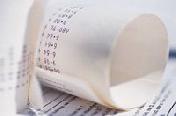
 |
|
| Financial Terms | |
| Asset for asset swap |
|
Information about financial, finance, business, accounting, payroll, inventory, investment, money, inventory control, stock trading, financial advisor, tax advisor, credit.
Main Page: accounting, payroll, inventory control, business, finance, money, investment, stock trading, |
Definition of Asset for asset swap
Asset for asset swapCreditors exchange the debt of one defaulting borrower for the debt of another
Related Terms:Asset swapAn interest rate swap used to alter the cash flow characteristics of an institution's assets so as to Acquisition of assetsA merger or consolidation in which an acquirer purchases the selling firm's assets. Amortizing interest rate swapswap in which the principal or national amount rises (falls) as interest rates AssetAny possession that has value in an exchange. Asset/equity ratioThe ratio of total assets to stockholder equity. Asset/liability managementAlso called surplus management, the task of managing funds of a financial Asset activity ratiosRatios that measure how effectively the firm is managing its assets.  Asset allocation decisionThe decision regarding how an institution's funds should be distributed among the Asset-backed securityA security that is collateralized by loans, leases, receivables, or installment contracts Asset-based financingMethods of financing in which lenders and equity investors look principally to the Asset classesCategories of assets, such as stocks, bonds, real estate and foreign securities. Asset-coverage testA bond indenture restriction that permits additional borrowing on if the ratio of assets to Asset pricing modelA model for determining the required rate of return on an asset. Asset substitutionA firm's investing in assets that are riskier than those that the debtholders expected. Asset substitution problemArises when the stockholders substitute riskier assets for the firm's existing Asset turnoverThe ratio of net sales to total assets.  Asset pricing modelA model, such as the Capital asset Pricing Model (CAPM), that determines the required AssetsA firm's productive resources. Assets requirementsA common element of a financial plan that describes projected capital spending and the Call swaptionA swaption in which the buyer has the right to enter into a swap as a fixed-rate payer. The Capital asset pricing model (CAPM)An economic theory that describes the relationship between risk and Circus swapA fixed rate currency swap against floating U.S. dollar LIBOR payments. Currency swapAn agreement to swap a series of specified payment obligations denominated in one currency Current assetsValue of cash, accounts receivable, inventories, marketable securities and other assets that Debt swapA set of transactions (also called a debt-equity swap) in which a firm buys a country's dollar bank Differential swapswap between two LIBO rates of interest, e.g. yen LIBOR for dollar LIBOR. Payments are Dynamic asset allocationAn asset allocation strategy in which the asset mix is mechanistically shifted in  Equity swapA swap in which the cash flows that are exchanged are based on the total return on some stock Exchange of assetsAcquisition of another company by purchase of its assets in exchange for cash or stock. Extension swapExtending maturity through a swap, e.g. selling a 2-year note and buying one with a slightly Financial assetsClaims on real assets. Fixed assetLong-lived property owned by a firm that is used by a firm in the production of its income. Fixed asset turnover ratioThe ratio of sales to fixed assets. Foreign exchange swapAn agreement to exchange stipulated amounts of one currency for another currency Intangible assetA legal claim to some future benefit, typically a claim to future cash. Goodwill, intellectual Interest rate swapA binding agreement between counterparties to exchange periodic interest payments on Intermarket spread swapsAn exchange of one bond for another based on the manager's projection of a Liability swapAn interest rate swap used to alter the cash flow characteristics of an institution's liabilities so Liquid assetasset that is easily and cheaply turned into cash - notably cash itself and short-term securities. Long-term assetsValue of property, equipment and other capital assets minus the depreciation. This is an Limitation on asset dispositionsA bond covenant that restricts in some way a firm's ability to sell major assets. Net asset value (NAV)The value of a fund's investments. For a mutual fund, the net asset value per share Net assetsThe difference between total assets on the one hand and current liabilities and noncapitalized longterm Non-reproducible assetsA tangible asset with unique physical properties, like a parcel of land, a mine, or a Other current assetsValue of non-cash assets, including prepaid expenses and accounts receivable, due Policy asset allocationA long-term asset allocation method, in which the investor seeks to assess an Publicly traded assetsassets that can be traded in a public market, such as the stock market. Pure yield pickup swapMoving to higher yield bonds. Put swaptionA financial tool in which the buyer has the right, or option, to enter into a swap as a floatingrate Quanto swapSee: differential swap. Quick assetsCurrent assets minus inventories. Rate anticipation swapsAn exchange of bonds in a portfolio for new bonds that will achieve the target Real assetsIdentifiable assets, such as buildings, equipment, patents, and trademarks, as distinguished from a Reproducible assetsA tangible asset with physical properties that can be reproduced, such as a building or Residual assetsassets that remain after sufficient assets are dedicated to meet all senior debtholder's claims in full. Return on assets (ROA)Indicator of profitability. Determined by dividing net income for the past 12 months Return on total assetsThe ratio of earnings available to common stockholders to total assets. Riskless or risk-free assetAn asset whose future return is known today with certainty. The risk free asset is Risky assetAn asset whose future return is uncertain. Risk-free assetAn asset whose future return is known today with certainty. Substitution swapA swap in which a money manager exchanges one bond for another bond that is similar in SwapAn arrangement whereby two companies lend to each other on different terms, e.g. in different Swap assignmentRelated: swap sale. Swap buy-backThe sale of an interest rate swap by one counterparty to the other, effectively ending the swap. Swap optioSee: swaption. Swap rateThe difference between spot and forward rates expressed in points, e.g., $0.0001 per pound sterling. Swap reversalAn interest rate swap designed to end a counterparty's role in another interest rate swap, Swap saleAlso called a swap assignment, a transaction that ends one counterparty's role in an interest rate SwaptionOptions on interest rate swaps. The buyer of a swaption has the right to enter into an interest rate Tactical Asset Allocation (TAA)An asset allocation strategy that allows active departures from the normal Tangible assetAn asset whose value depends on particular physical properties. These i nclude reproducible Tax swapswapping two similar bonds to receive a tax benefit. Total asset turnoverThe ratio of net sales to total assets. Underlying assetThe asset that an option gives the option holder the right to buy or to sell. Wasting assetAn asset which has a limited life and thus, decreases in value (depreciates) over time. Also ASSETSAnything of value that a company owns. Current assetsCash, things that will be converted into cash within a year (such as accounts receivable), and inventory. RATE OF RETURN ON TOTAL ASSETSThe percentage return or profit that management made on each dollar of assets. The formula is: AssetsThings that the business owns. Current assetsAmounts receivable by the business within a period of 12 months, including bank, debtors, inventory and prepayments. Fixed assetsThings that the business owns and are part of the business infrastructure – fixed assets may be Intangible fixed assetsNon-physical assets, e.g. customer goodwill or intellectual property (patents and trademarks). Tangible fixed assetsPhysical assets that can be seen and touched, e.g. buildings, machinery, vehicles, computers etc. AssetsItems owned by the company or expenses that have been paid for but have not been used up. Contra-asset accountAn offset to an asset account that reduces the balance of the asset account. Intangible assetsassets owned by the company that do not possess physical substance; they usually take the form of rights and privileges such as patents, copyrights, and franchises. asset turnover ratioA broad-gauge ratio computed by dividing annual current assetsCurrent refers to cash and those assets that will be turned fixed assetsAn informal term that refers to the variety of long-term operating return on assets (ROA)Although there is no single uniform practice for Asset-specific RiskThe amount of total risk that can be eliminated by diversification by Capital Asset Pricing Model (CAPM)A model for estimating equilibrium rates of return and values of Fixed Assets Turnover RatioA measure of the utilization of a company's fixed assets to Return on Total Assets RatioA measure of the percentage return earned on the value of the SwapAn exchange of cash flows between two counterparties. The Total Asset Turnover RatioA measure of the utilization of all of a company's assets to Total Debt to Total Assets RatioSee debt ratio asset turnovera ratio measuring asset productivity and showing the number of sales dollars generated by each dollar of assets capital assetan asset used to generate revenues or cost savings Related to : financial, finance, business, accounting, payroll, inventory, investment, money, inventory control, stock trading, financial advisor, tax advisor, credit. |